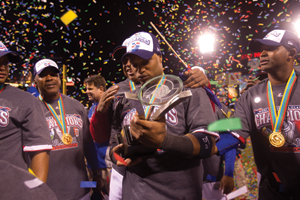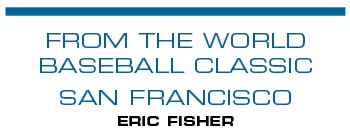As confetti rained down on the champion Dominican Republic team, an ebullient
Tim Brosnan, MLB executive vice president of business, stood on the edge of the AT&T Park infield, watched the Dominicans receive their medals, and called the 2013 World Baseball Classic an “unqualified, over-the-top success.” But never before has this event shown such a marked divide between its accelerating global gains and the far more meager returns at home in the U.S.
Plenty of data points support Brosnan’s position: record event attendance of 885,212 when new qualifier games were included, historically high TV ratings in many countries with teams in the tournament, online traffic to WorldBaseballClassic.com more than four times as high as the last tournament in 2009, increased corporate sponsorship, and improved play by several countries, including the Netherlands and Italy.
Fundamentally, the goal of the tournament is to advance baseball outside of the U.S., making those kinds of returns paramount.
But ideally, the World Baseball Classic builds the sport’s global appeal and influence from a strong foundation of support in America, and that foundation shows signs of distress.
The three championship-round games at AT&T Park drew a total of 96,913, down sharply from the 141,854 for the comparable set of games in Los Angeles in 2009, and the 126,603 from San Diego in 2006. Qualitatively, the San Francisco numbers were even weaker as dynamic pricing drove down face-value prices as low as $5. And the World Baseball Classic became an early example of the new $6 effective minimum price on StubHub established in MLB Advanced Media’s contract extension with the resale marketplace.
 |
The Dominican Republic, and MLB, celebrated a successful WBC.
Photo: GETTY IMAGES
|
Much of the fan malaise stemmed from another disappointing second-round exit by the U.S. team. It certainly does not help that many MLB general managers remain wary of the tournament because of player injury concerns. As a result, the 2013 U.S. team was a far cry from the best talent this country has to offer.
And given an inherent conflict between baseball’s increasing globalization and the more parochial lens through which many Americans view this tournament, further competitive and marketing challenges likely await.
“Sure, things would be different if the U.S. was here, but the blueprint is not to sell tickets in March in the U.S. for baseball games, but to accelerate the growth of baseball outside the U.S.,” said Larry Baer, president and chief executive of the San Francisco Giants, who had a strong interest in the event as host club for the championship round games and the Giants marketed the tournament to its season-ticket holder base, numbering about 30,000, with limited success.
Brosnan predicted the 2017 tournament will include additional countries beyond the 2013 field of 28 with an expanded qualifying round, and as a result, more WBC games outside of the U.S. He did not dismiss the possibility of even playing the championship-round games outside the U.S., though he acknowledged the increased logistical complexities of doing so. But if the business of the tournament beyond American borders continues to outpace the U.S., such a scenario is anything but far fetched.
“There are a thousand possibilities,” he said.
■ NETWORK GAINS: The picture was clearer for the MLB Network, which for the first time held exclusive English-language U.S. telecast rights for the tournament. The 2013 event was designed in part to be a further showcase of the network, now in its fifth year of operation and well regarded for its programming and production, but still posting an average cable rating of 0.1 in prime time.
The WBC generated the network’s six most-watched games ever outside of its limited coverage of the MLB playoffs, including 883,000 viewers for the U.S.-Dominican Republic clash March 14 and 843,000 for the title game. Beyond providing meaningful ratings lift compared with a normal March dominated by preseason programming, the tournament helped expose new fans to the network, which hopes for a lasting halo effect. The improved numbers, and plan for a return WBC engagement in 2017, also buttress the network’s position as it prepares to seek several key distribution renewals later this year.
“This gave us a real stage to show what we do to an expanded audience,” said Tony Petitti, MLB Network president. “This was our first big, consistent chunk of exclusive content. We had high expectations, and it really exceeded all of that.”
■ FIRED UP ABOUT TOURISM: Brand USA is now looking to extend its relationship with baseball after a successful promotional run during the WBC and an active on-site presence during the final set of games. The marketing arm of the U.S. Tourism Board brought Bobby Valentine, fired last fall as manager of the Boston Red Sox and now a spokesman for Brand USA and athletic director at Sacred Heart University, to San Francisco for the final set of games. Outside AT&T Park, Brand USA set up a digital photo kiosk where fans could have their picture taken with backdrops of virtual re-creations of the Grand Canyon, Gateway Arch, and other American landmarks, with those photos immediately available for sharing on social media platforms.
Commercial spots featuring Valentine also ran frequently on WBC game broadcasts and in tournament venues. Valentine additionally met with fans during first-round games in Fukuoka, Japan.
A potential next step is a deeper relationship with baseball in which Brand USA works with the league and various teams to get tickets and baseball-related assets in the hands of travel agents.
“This is a logical place for us to be, certainly with how baseball fits into peak travel activity during the summer,” said Michael Carroll, Brand USA vice president of partner marketing. “We’ll be going back to MLB and see about setting up a broader platform.”
Brand USA worked with New Jersey-based Source1 Sports on its WBC activation.





